1) Which of the following blood vessels carries blood away from the heart to other organs?
a) arteries
b) capillaries
c) venules
d) arterioles
e) veins
a
Which of the following blood vessels carries blood from the tissues back to the heart?
a) arteries
b) arterioles
c) aorta
d) veins
e) capillaries
d
Which layer of the arterial wall is responsible for vasoconstriction?
a) tunica interna
b) tunica media
c) tunica externa
d) tunica albuginea
e) tunica fascia
b
Which layer of the arterial wall is primarily composed of elastic and collagen fibers?
a) tunica interna
b) tunica media
c) tunica externa
d) tunica albuginea
e) tunica fascia
c
When an artery or arteriole is damaged, its smooth muscle layer contracts producing
a) tear in the vessel.
b) new vessel branching off the artery or arteriole.
c) a vascular spasm.
d) tetanus.
e) increased blood flow to the damaged vessel.
c
Elastic arteries function as
a) vasodilators.
b) conduits to the tissues of the trunk only.
c) barriers to microcirculation.
d) pressure reservoirs.
e) vasoconstrictors.
d
In resting individuals, which vessels serve as a large blood reservoir from which blood can be quickly diverted to other vessels as needed?
a) Arteries and arterioles
b) Arterioles and capillaries
c) Venules and capillaries
d) Veins and venules
e) Aorta and veins
d
Which type of blood vessel plays a key role in regulating blood flow into capillaries?
a) arteries
b) arterioles
c) venules
d) veins
e) aorta
b
Which of the following structures are found in veins but NOT in arteries?
a) tunica externa
b) tunica media
c) tunica interna
d) valve
e) lumen
d
Capillaries are also referred to as
- a) exchange vessels.
- b) vasoconstrictors.
- c) vasodilators.
- d) pressure reservoirs.
e) distributing vessels
a
Which of the following structures is used to control the flow of blood through a capillary bed?
a) thoroughfare channels
b) precapillary sphincters
c) postcapillary sphincters
d) venules
e) valves in veins
b
Which of the following types of tissues contains continuous capillaries?
a) skeletal muscle
b) smooth muscle
c) connective tissue
d) lungs
e) all of these choices
e
The alternate route of blood flow to a body part through an anastomosis is called
a) a thoroughfare channel.
b) a blood reservoir.
c) a detour route.
d) collateral circulation.
e) microcirculation.
d
The largest driving force for pulling fluid from the interstitial spaces back into the capillaries is
- a) interstitial fluid hydrostatic pressure.
- b) interstitial fluid osmotic pressure.
- c) blood colloid osmotic pressure.
- d) blood hydrostatic pressure.
e) glomerular hydrostatic pressure
c
The pressure-driven movement of fluids and solutes from blood into interstitial fluid is called
a) reabsorption.
b) filtration.
c) bulk flow.
d) osmosis.
e) transcytosis.
b
The volume of blood that circulates through the systemic (or pulmonary) blood vessels per minute is called
a) stroke volume.
b) tidal volume.
c) cardiac output.
d) cardiac reserve.
e) total peripheral resistance.
c
Cardiac output is dependent on both
a) heart rate and stroke volume.
b) stroke volume and systemic vascular resistance.
c) heart rate and systemic vascular resistance.
d) blood type and stroke volume.
e) blood pressure and heart rate
a
Which of the following would NOT result in an increase in arterial blood pressure?
a) Increased blood volume
b) Increased sympathetic stimulation
c) Increased heart rate
d) Increased stroke volume
e) Increased arteriolar vasodilation
e
Which of the following would NOT result in an increase in systemic vascular resistance?
a) Decreased diameter of systemic arterioles
b) Increased blood viscosity
c) Decreased length of the systemic circulatory route
d) Increased vasoconstriction of systemic arterioles
e) Increased red blood cell count
c
Which of the following characteristics of blood depends mostly on the ratio of RBCs to plasma volume?
a) total blood volume
b) blood viscosity
c) venous return
d) clotting time
e) immunoglobulin profile
b
Which of the following is NOT a contribution of the cardiovascular system to other body systems?
a) Blood delivers clotting factors and WBCs that aid in hemostasis when skin is damaged.
b) Blood delivers calcium and phosphate ions that are needed for building bone extracellular matrix.
c) Blood carries carbon dioxide to body tissues and removes oxygen for use by other organs.
d) Blood carries newly absorbed nutrients and water to the liver.
e) Blood circulates cells and chemicals that carry out immune functions.
c
The cardiovascular center is located
a) in the thoracic cavity.
b) in the cerebral cortex.
c) in the cerebellum.
d) in the medulla oblongata.
e) in the hypothalamus.
d
All of the following aid in venous return of blood to heart EXCEPT
a) the skeletal muscle pump.
b) the respiratory pump.
c) blood viscosity.
d) venoconstriction
d
All of the following aid in venous return of blood to heart EXCEPT
a) the skeletal muscle pump.
b) the respiratory pump.
c) blood viscosity.
d) venoconstriction
e) venous valves.
c
Which of the following would be a normal response of the cardiovascular system to a decreased frequency of action potentials arising from the baroreceptors?
a) Increased systemic vascular resistance
b) Increased parasympathetic stimulation
c) Decreased heart rate
d) Decreased stroke volume
e) Decreased cardiac output
a
Which of the following hormones would NOT stimulate changes that lead to an increase in arterial blood pressure?
a) Atrial natriuretic peptide(ANP)
b) Antidiuretic hormone(ADH)
c) Aldosterone
d) Angiotensin
e) Epinephrine
a
When chemoreceptors in blood vessels detect high levels of carbon dioxide in the blood, they stimulate all of the following changes EXCEPT
a) increased vasoconstriction of arterioles.
b) increased blood pressure.
- c) decreased respiratory rate.
- d) increased sympathetic stimulation of arterioles and veins.
e) increased vasoconstriction of veins
c
The myogenic response of smooth muscle results in
a) more forceful contractions when stretched.
b) more forceful contractions when relaxed
c) tetany.
d) relaxation of smooth muscle when stretched.
e) formation of new desmosomes.
a
In which of the following types of blood vessels is blood pressure
NOT pulsing?
1. Arteries
2. Capillaries
3.
Arterioles
4. Venules
a) 1 only
b) 2 only
c) 3 only
d) 4 only
e) Both 2 and 4
e
Abnormal conditions such as atherosclerosis and patent ductus arteriosus cause an large increase in the
- a) blood colloid osmotic pressure.
- b) central venous pressure.
- c) pulse pressure.
- d) venular hydrostatic pressure.
- e) capillary hyrdostatic pressure.
c
This type of shock is due to decreased blood volume.
a) Hypovolemic
b) Cardiogenic
c) Vascular
d) Obstructive
e) Neurogenic
a
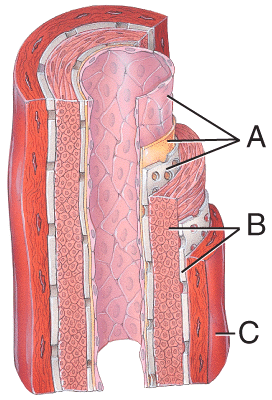
Which of the labeled layers in the diagram of the arterial wall consists mainly of elastic fibers and smooth muscle fibers?
a) A
b) B
c) C
d) A and B
e) A, B and C
b

Which of the labeled layers in the diagram of the arterial wall is composed of a simple squamous epithelium, a basement membrane and a layer of elastic tissue?
- a) A
- b) B
- c) C
- d) A and B
- e) A, B, and C
a

Which labeled structure in the figure is a metarteriole?
- a) A
- b) B
- c) D
- d) F
- e) E
b

Which labeled structure in the figure is a capillary?
- a) A
- b) B
- c) C
- d) D
- e) E
d
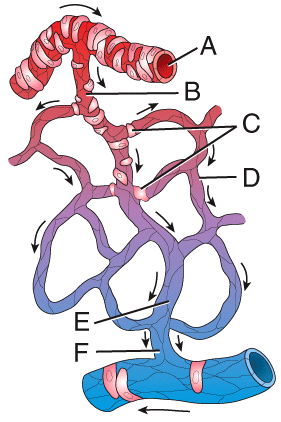
Which labeled structure in the figure is precapillary sphincter?
- a) A
- b) B
- c) C
- d) D
- e) E
c
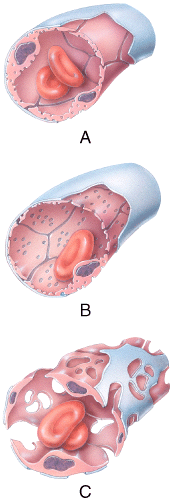
Which of the capillaries shown in the figure has an incomplete or absent basement membrane?
- a) A
- b) B
- c) C
- d) A and B
- e) A, B, and C
c
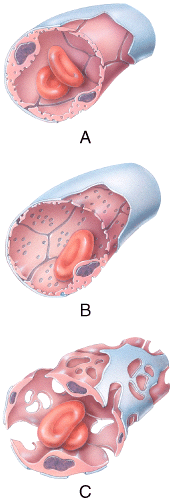
Which of the types of capillaries shown in the figure is commonly found in the kidneys, villi of the small intestine, choroid plexuses, and some endocrine glands?
- a) A
- b) B
- c) C
- d) A and B
e) B and C
b
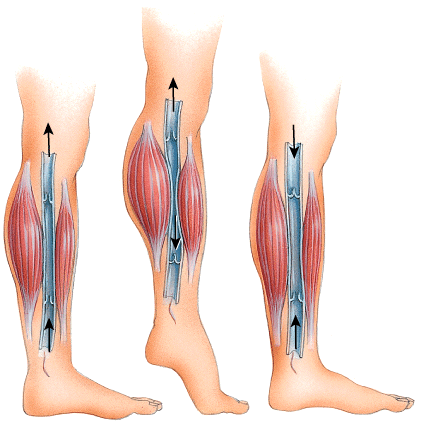
What physiological process is depicted in this figure?
- a) Venous blood blockage
- b) Skeletal muscle pump
- c) Respiratory pump
- d) Thoroughfare channels
- e) Anastomosis
b
What do following arteries have in common: superficial temporal artery, brachial artery and common carotid artery?
a) They are all areas where Korotkoff sounds cannot be heard.
b) They are all only found on the left side of the body.
c) They are all common pulse points.
d) They all contain baroreceptors.
e) They all deliver blood to structures in the head.
c
Which of the following would NOT occur in response to hypovolemic shock?
a) Activation of the renin-angiotensin-aldosterone (RAA) system.
b) Secretion of antidiuretic hormone (ADH)
c) Activation of the sympathetic division of the ANS.
d) Release of atrial natriuretic peptide (ANP).
e) Release of local vasodilators.
d
All the veins of the systemic circulation eventually drain into the
a) superior vena cava.
b) inferior vena cava.
c) coronary sinus.
d) superior and inferior vena cava.
e) superior and inferior vena cava and coronary sinus.
e
The pulmonary trunk divides into
a) brachiocephalic trunk and left subclavian artery
b) right and left subclavain arteries.
c) right and left pulmonary veins.
d) right and left pulmonary arteries.
e) right and left common carotid arteries.
d
In fetal circulation, what is the opening between the right and left atria called?
a) Ductus venousus
b) Umbilicus
c) Fossa ovalis
d) Foramen ovale
e) Ductus arteriosus
d
Which of the following vessels is a pulse point found at the wrist?
a) Radial artery
b) Subclavian artery
c) Axillary artery
d) Cephalic artery
e) Palmar artery
a